Matthew J Poes
AV Addict
Thread Starter
- Joined
- Oct 18, 2017
- Messages
- 1,903
I thought I would share a little response data to make a point about listening off axis. Most people believe that listening to a speaker on-axis, meaning that the center axis of the speaker is aimed at your ears, gives the best response. This is frequently not the case and in some cases, flaws in a speakers response that show up on-axis disappear off-axis. Most speakers do not have a crossover optimized for on-axis but rather for the power response (the average of the response across a 90 degree angle, at some set of increments, such as every 2.5 degrees, 5 degrees, etc.). This is because a speaker:

On axis, not flat and DI not ideal

20 degree listening axis (how they should be listened to), note the flatter DI

On axis, note the response and DI

26 degrees, Ideal listening axis based on DI shape and flattest response
As you can see, sometimes listening off of the central axis actually gives you a better response and better (smoother) response change as you move off of that listening axis. That means as your head moves the response doesn't really tonally shift. It also means that reflections such as first reflections will have the same response shape (just reduced in level) as the on-axis. That's good stuff!
There is more value to this. What I've shared are the response of two speakers which have a flat response, well designed crossovers with good driver integration, and nearly ideal directivity. Most speakers do not look like this. However, you can use knowledge of this information to get a better sound from the speaker. My experience is that many speaker manufacturers either do not give a preferred listening axis or their recommendation doesn't match the response data for their speaker (meaning their recommendation is not ideal). Even measurements taken in room can give you the necessary information to know what angle provides the best and flattest response (though you won't be able to calculate the polar response or DI accurately this way, that isn't absolutely necessary for setup).
Stay tuned for more details soon. I am finishing up a review where this became very helpful in getting the best out of the speakers. What I love about this tweak is that it can be a totally free fix that can have as big a benefit to sound as a fairly major change to the speaker. It can be like turning it into a totally new speaker, with a drastic tonal change for the better. This is primarily beneficial when a speaker has a bright tonal balance with a measurably elevated top end.
Now as a quick primer, remember that on axis means the speakers are pointed at your head, not straight toward the wall behind you. 20 degree listening axis means rotated 20 degrees inward from the axis pointed at your head. A speaker's proper toe angle often looks very extreme.

Above shows a speaker pointed directly toward the back wall. This is generally not the right way to position the speaker.

This is with the speakers pointed on axis, pointed toward your head. This is 0 degrees.

This is the speaker's pointed at 20 degrees from on axis, as you can see their on axis response actually crosses in front of the listener
- May not be listened on axis, and
- Needs to reflect sound in the room with the same response shape as the listening axis (otherwise the reflections will sound different from the direct sound)
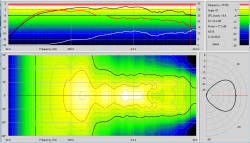
On axis, not flat and DI not ideal
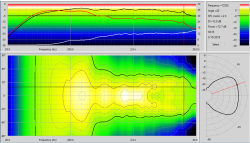
20 degree listening axis (how they should be listened to), note the flatter DI
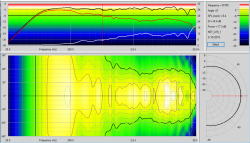
On axis, note the response and DI
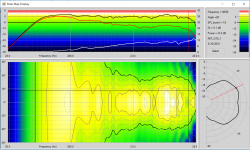
26 degrees, Ideal listening axis based on DI shape and flattest response
As you can see, sometimes listening off of the central axis actually gives you a better response and better (smoother) response change as you move off of that listening axis. That means as your head moves the response doesn't really tonally shift. It also means that reflections such as first reflections will have the same response shape (just reduced in level) as the on-axis. That's good stuff!
There is more value to this. What I've shared are the response of two speakers which have a flat response, well designed crossovers with good driver integration, and nearly ideal directivity. Most speakers do not look like this. However, you can use knowledge of this information to get a better sound from the speaker. My experience is that many speaker manufacturers either do not give a preferred listening axis or their recommendation doesn't match the response data for their speaker (meaning their recommendation is not ideal). Even measurements taken in room can give you the necessary information to know what angle provides the best and flattest response (though you won't be able to calculate the polar response or DI accurately this way, that isn't absolutely necessary for setup).
Stay tuned for more details soon. I am finishing up a review where this became very helpful in getting the best out of the speakers. What I love about this tweak is that it can be a totally free fix that can have as big a benefit to sound as a fairly major change to the speaker. It can be like turning it into a totally new speaker, with a drastic tonal change for the better. This is primarily beneficial when a speaker has a bright tonal balance with a measurably elevated top end.
Now as a quick primer, remember that on axis means the speakers are pointed at your head, not straight toward the wall behind you. 20 degree listening axis means rotated 20 degrees inward from the axis pointed at your head. A speaker's proper toe angle often looks very extreme.
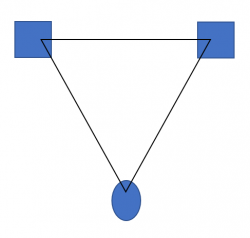
Above shows a speaker pointed directly toward the back wall. This is generally not the right way to position the speaker.
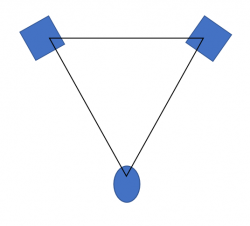
This is with the speakers pointed on axis, pointed toward your head. This is 0 degrees.
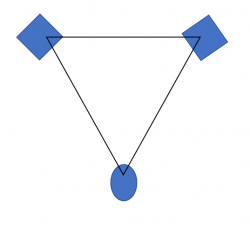
This is the speaker's pointed at 20 degrees from on axis, as you can see their on axis response actually crosses in front of the listener










